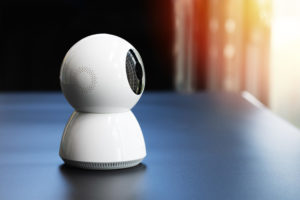We recommend five top motion-activated cameras
Best Motion-Detector Cameras
Security cameras are useful tools, but they’re impossible to watch all the time. If you look away, you might miss something... unless you have motion-detector cameras.
We’ve scoured the market for the best motion-detector cameras from Google, Arlo, Wyze, and more so that you can pick what works best for you.
- : Best value
- : Best extras
- : Best smart home addition
- : Best for outdoors
- : Best budget pick

Data effective 08/16/2022. Offers subject to change.
What to look for in a motion-detector camera
Cameras with motion detection make video surveillance more realistic for the average person. By alerting you only when something happens, they save you a lot of time staring at a screen.
A motion-detector camera uses a motion sensor to pick up on movement. Typically, unless the camera uses continuous recording, recording will start only when the sensor detects motion.
To learn more about motion sensors, check out our Motion Sensors Guide.
When buying a camera, especially a motion-detector camera, look at the following:
- Resolution
- Two-way audio
- Night vision
- Storage
- Subscription cost
- Field of view
- Compatibility
For further info, you can jump to What should I look for in a motion-detector camera?
Motion-detection features that work best for homes and apartments:
- Automatic zoom
- People detection
- Facial recognition
- Geofencing
- Cloud storage
Let’s quickly walk through these features.
We like motion-activated cameras with automatic zoom because they automatically focus on the areas with motion.
People recognition and facial recognition help you differentiate between humans, vehicles, animals, packages, the wind, and anything else that might grab a camera’s attention. Most of the cameras we’ve tested have reliable person detection, but in the industry, facial recognition in general is still a work in progress.
Geofencing means that your cameras will automatically turn on when you leave the house. You'll love this smart setup option if you don't want your cameras on when you're at home.
Cloud storage means that all your digital video files will be saved digitally instead of on a physical device. You can log into your account and see your clips from anywhere.
Nest Cam: Best value
If you want to squeeze the most out of every dollar, we recommend the indoor, wired version of the Nest Cam (successor to the Nest IQ Indoor Cam). It boasts activity zones, facial recognition, encrypted video, and a 45% recycled body.
All you really need in an indoor camera like this is motion detection to let you know when someone is there. But the Nest Cam goes way beyond that with activity zones that let you target specific areas and facial recognition that alerts you to familiar faces.
We tried Nest’s last facial recognition iteration, and it didn’t work as smoothly as we hoped. For instance, it had difficulty recognizing people from slightly different angles. But even if the Nest Cam facial recognition is the same as the Nest IG Indoor Cam, in many cases, spotty facial recognition is an improvement over no facial recognition.
The encrypted video provides an extra layer of protection against hacking (unlikely, but possible). And the 45% recycled plastic helps you feel good about the sustainability of your camera choice.
Unlike previous Nest cameras, the Nest Cam is a very affordable $99.99. However, on top of the one-time camera purchase, you’ll also need to pay a recurring fee for cloud storage.
Data effective 08/16/2022. Offers subject to change.
Both Nest subscription plans support all your Nest devices and offer emergency calling, familiar face recognition, and smoke/carbon monoxide and glass break alerts.
Nest equipment
This Google Nest Cam comes in four subtle colors, something you don’t usually see with security cameras. There’s even a version with a maple wood base on the Google store.
We’ve picked the indoor, wired version for this curated list. In this case, “wired” means “plug-in.” You can mount the camera to the wall using the included mount or place it on a side table—anywhere that’s in reach of an outlet. Just make sure you keep it indoors as this one isn’t rated for outdoor use.
The Nest Cam works with other Nest devices, Google Assistant (through the app, a Nest Hub, or a legacy Google Home device), and Amazon Alexa.
Canary All-In-One Indoor: Best extras
Keep track of your home’s climate while staying alert with Canary All-in-One Indoor. This small camera includes a siren, environmental sensors, and a day of free storage.
Canary comes with an air quality sensor, a temperature sensor, and a humidity sensor. The air quality sensor helps you know if your air is unhealthy to breathe. The temperature and humidity sensors indicate if you have to adjust the thermostat or dehumidifier in your home. If you have asthma or other disabilities or live in a smoggy area, these sensors are a lifesaver—literally.
Like Nest, Canary has software to tell you if you’re looking at a person or some other kind of motion. But unlike Nest, Canary can’t sense human faces, so we’re not sure how Canary knows which is which. Some reviewers complain that the tech has a hard time telling people from pets.
We’re a little surprised that Canary put so much into the environmental sensors when they aren’t directly related to security. Don’t get us wrong; we think they’re cool and that more cameras could benefit from them. But since the Canary is primarily a camera, we wonder why the designers didn’t put as much effort into refining the person-tracking tech.
This particular Canary has tons of features but isn’t even the most versatile camera from the brand. You can only use it indoors. If you’re looking for an outdoor camera, you should look at the Canary Weatherproof Flex.
If you’ve ever dreamed of having a flock of Canaries, the price is gonna be a deterrent. The cameras themselves are not crazy expensive, but unlike Nest, Canary doesn’t charge a flat fee for video access. Instead, it charges by the device.
The $9.99 plan, which gives you 30 days of storage, costs $2.99 a month or $29.99 a year for each additional device. That gets really expensive, really fast.
Luckily, the version we recommend comes with a free year of service. And after that, if you don’t want to pay for extended storage, you get a complimentary 24 hours’ worth.
Data effective 08/16/2022. Offers subject to change.
If you don’t pay for a Canary plan, you won’t get motion-activated recording, person alerts, video history, video storage, or anything else besides two-way audio. So you can talk, and you can listen, but you won’t get any video clips or alerts.
Canary equipment
The Canary is plug-and-play: just plug it into an outlet, connect it to Wi-Fi, and you’re good to go.
If you’re using a Wi-Fi connection to send the video directly to your device in real time, things can get buggy, especially if you’re using an outdoor camera. If you can use Ethernet without compromising security, do it. It’s just more reliable.
This camera works with both Amazon and Google, so you don’t have to convert your home to one ecosystem to fit with the camera. You can use what works for you.
Zmodo Pivot Cloud: Best smart home addition
If you want a 1080p indoor camera that’s also a smart home hub, Zmodo Pivot is the right way to go.
To call the Zmodo Pivot a camera is something of a stretch. It’s more of a smart home hub with a Bluetooth speaker and motion-detector camera built in. That makes the versatile Zmodo a great acquisition for almost any smart home enthusiast.
The Zmodo Pivot Cloud is compatible with Alexa and Google Assistant, so you can control it with your Amazon Echos and Nest Hubs. Like the Canary, it also has temperature and humidity sensors. And, to put the icing on the cake, it comes with four door/window sensors to create a home security system lite.
Have you ever been watching something in motion and been annoyed that you had to physically rotate your body to continue watching it? If you have, you’re in for a treat with Zmodo.
The Zmodo Pivot Cloud detects motion and tracks it all the way around. Technically it’s a 350° rotation, but you can still see the full spectrum. You can even control the rotation from your phone.
The camera can’t pivot past its starting point. To get back to position 0 from 350°, it can't turn that final 10 degrees. It has to rotate back around the way it came.
Zmodo charges for subscription plans by the camera. Every camera gets 16 GB of free local storage. If you need more than that, cloud starts at $4.99 a month for seven days of rotating storage.
For 30 days, it’s $9.99.
Data effective 08/16/2022. Offers subject to change.
We recommend the 7-Day Plan as seven days of rolling storage will be enough for most homes. But if your house is particularly active or you want to keep clips around longer than a week, you should splurge for 30.
Zmodo equipment
The Zmodo Pivot is an indoor camera with plug-in power, so you’ll need to place it near an outlet but in a spot where it can fully use its rotational abilities. That makes Zmodo placement a bit challenging.
Zmodo refers to the Pivot as a smart home hub, and it is—for Zmodo sensors. You won’t be able to use other smart home devices with your Zmodo camera as a hub, although you can use the camera as a smart home device using an Echo or Nest Hub as a hub. Hubception?
Arlo Ultra 2: Best for outdoors
This outdoor camera is top of the line but is expensive.
The Arlo Ultra 2 deserves the buzz. It combines a camera with a siren and motion-activated spotlight. Plus, it has stunning color night vision, automatic zoom, and geofencing capabilities.
The Arlo Ultra has 2 fantastic video quality. It’s 4K, which is the equivalent of 2160p. The extra-special part about the image quality, though, is the color night vision. We like seeing things in color, even if it’s a little muted.
Security experts widely acknowledge motion-activated spotlights as general crime deterrents. Your Arlo Ultra 2 camera uses a spotlight to give your home that extra protection.¹
If you see something on camera that alarms you, activate the siren to scare off intruders. It’s not the loudest siren we’ve ever heard, so its reach may be limited, but it’ll definitely frighten any baddies.
The biggest downside is that it costs almost $300 to take this beauty home. That’s by far the most expensive camera on our list.
The Arlo Ultra 2 requires a special storage plan called Arlo Secure Plus ($9.99 a month for unlimited cameras). No plan, no play.
The camera does come with three free months of storage. After that, though, you have to pay to use your already-expensive device.
Data effective 08/16/2022. Offers subject to change.
The Arlo Ultra 2 comes with SD card storage through its hub, so you can always go with that. But you won’t be able to access any of your videos remotely. You’ll have to physically remove the SD card and pull the clips to see them.
Arlo equipment
Like many Arlo cameras, the Arlo Ultra 2 requires a base station/Arlo Smarthub to function. Many Arlophiles already have base stations, so we didn’t include it in the initial price—but if you need to get a base station, you’ll want to check out this Arlo Ultra 2 package instead of a standalone camera.
If you’re looking at an Arlo Ultra 2 outdoor security camera, you’ll love the wirefree design. That means no wires, no plugs, and 100% rechargeable batteries.
And if you’re into smart homes, this camera works with Amazon Alexa, Google Assistant, Apple HomeKit, and IFTTT. You can access the video feed with your chosen voice assistant or add it to a custom IFTTT smart chain.
Wyze Cam Pan: Best budget pick
The Wyze Cam Pan is très affordable yet has automatic zoom, person detection, and sound detection. Score!
Like the Zmodo Pivot, the Wyze Cam Pan pans and tilts—but unlike Zmodo, it has a full 360° view. It also has 8X automatic zoom so you can get real close and personal with anything on screen.
The Cam Pan has person detection, so you’ll know if someone’s in the same room as the camera. Plus it has sound detection, so if someone’s in the same house as the camera, you’ll probably know that too. Even sneaky people make noise.
If you want something that’s low cost but you aren’t sold on Wyze, we’ve got an entire list of cheap security cams to pull from.
Wyze has a limited free plan. You’ll get short, motion-activated “snapshot” recordings with five-minute cooldowns in between. You won't get a complete recording if something happens, but you'll see some of it.
The Cam Plus plan gets you full recordings with no required cooldown period. Plus it comes with the person and sound detection—you won’t get those with the free plan.
Data effective 04/27/2022. Offers subject to change.
We recommend the Cam Plus, just because you get so much more than with the Basic. And we suggest paying for a year at a time—you’ll save around $9 every 12 months that way. Wyze's Cam Plus Lite subscription allows you to "name your price" for access to 12 seconds of storage.
Wyze requires a separate plan for each camera, so if you have more than one, know you’ll have to multiply the subscription cost.
Wyze equipment
Like most indoor cameras, the Wyze Cam Pan is plug-in only. That’ll limit where you can place the camera, but it conversely means that you’ll never have to charge the batteries.
The Wyze Cam Pan is compatible with Alexa and IFTTT. It’s also compatible with Google Assistant—but only through the Google Chromecast device. It won’t be simpatico with that old Google Home gathering dust in your living room.
Recap: Best motion-detector cameras for homes and apartments
- Nest Cam is our top recommendation because you get such good features (including facial recognition) at a reasonable price.
- Canary’s air quality sensor, thermometer, and humidity sensor give it a lot more features than your average camera.
- The Zmodo Pivot Cloud is a smart home hub with a Bluetooth speaker and a rotating camera.
- If you’re looking for the ultimate outdoor camera, Arlo Ultra 2 has color night vision, a spotlight, and a siren.
- The Wyze Cam Pan is a solid choice if you need a cheap alternative.
If you’re just looking for a good security camera, with or without motion detection, check out our best home security cameras.
Methodology
To pick our top motion-detector cameras, we pulled from our other camera best lists and compared price and features:
- Resolution
- Two-way audio
- Night vision
- Storage
- Subscription cost
- Field of view
We spent hours looking at different camera models and running tests to determine the best recommendations for this review.
Haven't tested any of these models (and testing database didn't have notes from anyone else) but I've used several of the predecessors which helped inform the review.
Motion-detector camera FAQ
If you aren’t satisfied with our picks, you may want to look at a full-blown security system with cameras.
To get camera access, you might have to subscribe to the brand’s top-tier service plan. Usually, this plan includes other security equipment like window and door sensors, motion detectors, and more.
This sort of service usually runs $50–$70 per month, even with companies that offer cheap home security. That adds up quickly, but those pricier plans include the fullest (and generally safest) coverage for you and your family.
The best home security system with the best home security cameras is probably Vivint, but you’ll want to make sure the system you pick fits your home’s needs.
When it comes to motion-detection cameras, we recommend looking at the following:
- Resolution
- Two-way audio
- Night vision
- Storage
- Subscription cost
- Field of view
- Compatibility
Resolution
- The standard for security cameras these days is 1080p, although some, like the Arlo Ultra 2, come in 4K. (For a comparison point, 4K works out to 2160 pixels.) Basically, you just gotta be able to see clearly. If your camera gives you a smudgeless view, you’re golden.
Two-way audio
Sound can reveal things you won't get from video alone, so we urge you to upgrade if your current security camera doesn't have audio.
All of our picks have two-way communication, which allows you to both hear and speak to the person on camera. Talking directly to them is an effective way to either scare the intruder off or resolve misunderstandings.
Night vision
A security camera, especially an outdoor one, should have night vision. All kinds of sneaky activities take place at night, and you want to be able to see them.
The Arlo Ultra 2’s color night vision is luxurious, but plain, black-and-white night vision is fine too.
Video storage
- Most security cameras have cloud storage nowadays, although some, like the Arlo Ultra 2, also have an SD option.
Subscription cost
- A lot of camera manufacturers charge for their cloud storage services, so read the fine print before buying a camera. You don’t want to unintentionally get saddled with an expensive camera that requires pouring even more money into high monthly fees.
Compatibility
Do you have an Alexa-only home? Or are you crazy about Apple HomeKit? We think that if you’re going to buy a home security camera, you should make sure it will work with your smart home.
Depending on your setup and the brands you choose, you can create some complicated and cool smart home hacks—like having your cameras automatically start recording if your alarm goes off.
Related Articles





